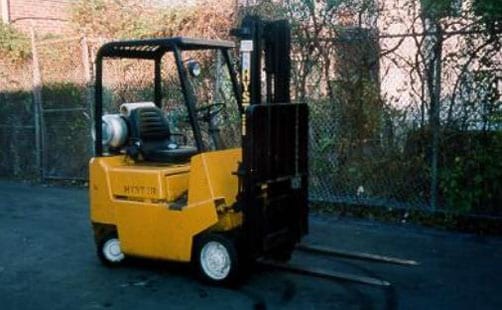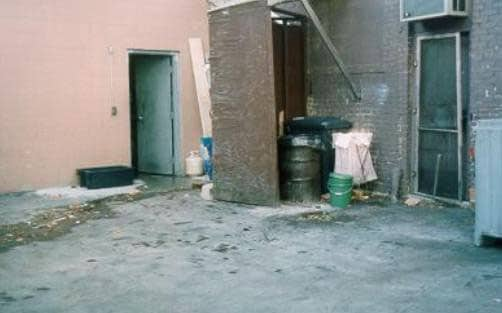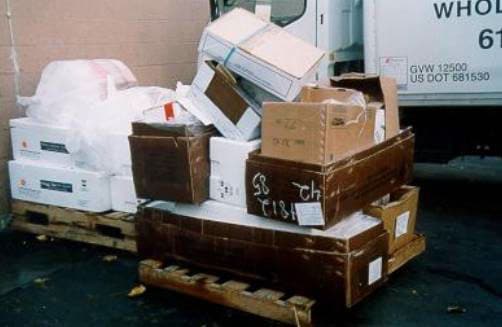Massachusetts Youth Killed While Operating Forklift at Seafood Processing Facility
Massachusetts FACE 00-MA-058
SUMMARY
On October 20, 2000, a 16-year-old male part-time cleaning helper (the victim) was fatally injured when the forklift he was operating at a seafood processing/retail facility overturned pinning him, and crushing his chest. The victim was operating the forklift to move a wooden pallet loaded with trash. The load was raised approximately 4½ feet when the victim made a right-hand turn causing the forklift to overturn. The victim either jumped or was thrown from the forklift operator’s seat. When the forklift overturned, the falling object protective structure (FOPS) of the forklift landed on his chest. A call was placed for emergency assistance as the owner, manager, and a witness assisted the victim. Emergency assistance arrived within minutes and transported the victim to a hospital where he died early the next morning from his injuries. The Massachusetts FACE program concluded that to prevent similar occurrences in the future, employers should:
- comply with federal and state child labor laws which prohibit youth less than 18 years old from operating forklifts
- train all forklift operators in safe operating procedures
- provide adequate supervision for young workers, new employees and any inexperienced workers
- develop, implement and enforce a written comprehensive health and safety program
In addition, agencies that have contact with small businesses, such as government and insurance agencies should:
- increase their efforts to inform businesses about child labor laws
INTRODUCTION
On October 25, 2000, the Massachusetts FACE Program was notified by the Occupational Safety and Health Administration (OSHA) through the 24-hour Occupational Fatality Hotline, that on October 20, 2000, a 16-year-old male, part-time cleaning helper, was fatally injured when crushed by a forklift. On November 20, 2000, the Massachusetts FACE Program Director and an investigator traveled to the seafood processing/retail facility where the two owners were interviewed. The police report, death certificate, OSHA fatality/catastrophe report, photographs, and interviews were obtained during the course of the investigation.
The employer, a seafood processing, wholesale, retail and mail order company, was in business approximately 20 years at the time of the fatality, and had been at the current location for 6 years. On average, the company employed 18 individuals. This included a number of teenagers some as young as 14 years old, who sometimes operated the forklift. The victim and one other teenager, also 16 years old, were present at the time of the incident and held the same job title as part-time cleaning helper. The company did not have a designated individual in charge of safety, and did not have written specific safety procedures for individual tasks. In addition, using the seatbelt while operating the forklift was neither encouraged nor enforced.
The victim, a full-time student at a local high school, had been employed with the company for approximately 18 days. His training was on-the-job and was conducted by the other teen employees. There was no union representation at this company.
INVESTIGATION
The company was a family owned seafood-processing facility with a retail storefront, which also sold seafood by wholesale and mail order. The seafood was purchased both locally and internationally and was shipped by airfreight and/or trucked to this facility where it was processed. Processing the seafood consisted of hand cutting it into filets and steaks. The processed seafood was then packaged and sold at their retail store, to restaurants, supermarkets and by mail order.
Typically, the victim and other part-time cleaning helpers worked 4-days a week: 3-days during the week after school (3:00pm – 6:00pm) and on Saturday (12:00pm – 5:00pm). The tasks the victim was typically assigned in the processing area included; placing all seafood in the walk-in refrigerator; cleaning and sanitizing all tables, processing benches, walls, floor and skinning machine, then preparing the processing facility for the next day.
Assigned tasks in the retail store and office area for part-time cleaning helpers included: emptying all trash barrels and cleaning and deodorizing floors, bathrooms, benches, scales, retail cases, sink, knives and cutting boards. In addition, the seafood was removed from shipping cases and placed in containers, which were then placed in tubs with ice, labeled and moved into the walk-in refrigerator. The retail store windows and the retail freezer case doors were washed. Also knives were dipped into an antibacterial chemical and the supply of retail shipping boxes, containers and lids were restocked.
The facility parking/loading dock area was located behind an adjoining facility, paved and measured approximately 50 feet long by 35 feet wide, with a driveway along the building leading to the street. Outdoor tasks in this parking/loading dock area included, placing collected trash into containers on wooden pallets and wrapping the pallets and the container with plastic. Unused wooden pallets were stacked and placed in a corner of the parking/loading dock area along with empty tubs and containers. After these tasks are completed, the gate to the yard was locked.
The company owned one forklift that they purchased approximately 6 months prior to the fatality from a local distributor. The forklift was an 11-year-old, propane powered, four wheeled, remanufactured forklift, which was purchased to replace an older, smaller electric forklift. There was no owner/user manual supplied with the forklift upon delivery to the facility. The owners reported that the delivery person showed them the basics of how to operate the forklift before leaving. On the day of the incident, the seatbelt was not being used, due to it being wedged beside the seat.
On the day of the incident, the victim had attended school and arrived at work at approximately 3:00pm. In addition to the other two teen workers, one of the company’s owners and a manager were onsite inside the facility office. The incident occurred approximately 20 minutes before the end of the victim’s work shift. The victim and another teen employee were finishing up the outdoor tasks, specifically moving and stacking empty tubs and placing trash onto wooden pallets. Management was aware that the young employee working with and “supervising” the victim would occasionally operate the forklift to move wooden pallets. The company owners were not sure if the victim had operated the forklift prior to this incident.
The victim had been operating the forklift with a load of approximately 70 pounds raised 4½ feet. He was driving the forklift in the forward direction and while making a right-hand turn the forklift started to overturn. As the forklift was overturning, the victim either jumped or was thrown from the operator’s seat and the overhead guard landed on his chest, pinning and crushing him.
The other teen employee ran into the facility office to notify the owner. A call was placed for emergency assistance and then the owner, manager, and the teen went to assist the victim. The owner, the manager, several police officers, fire department personnel, and employees of the neighboring pizza parlor all lifted the forklift freeing the victim. The victim was conscious while being transported to a local hospital and died the next day of the injuries sustained in the incident. It is not clear whether the victim was driving to fast at the time of the incident.
CAUSE OF DEATH
The medical examiner listed the cause of death as crushing injuries of chest and abdomen.
RECOMMENDATIONS/DISCUSSION
Recommendation #1: Employers should comply with federal and state child labor laws which prohibit youth less than 18 years old from operating forklifts.
Discussion: State and federal child labor laws are intended to protect working youth by prohibiting their employment under conditions that would be detrimental to their health or well being. These laws establish minimum ages for employment, limit the hours and times of day youth can work and prohibit employment of youth in certain jobs/tasks deemed as particularly hazardous for young workers. The federal Fair Labor Standards Act prohibits youth less than 18 years old in nonagricultural occupations from operating power driven hoisting apparatus including forklifts. In addition, the Massachusetts state child labor law prohibits workers less than 18 years old from operating any motor vehicles, including forklifts (Massachusetts General Laws Part II Title XXI Chapter 149 Section 62).
In this case, workers less than 18 years old were allowed to operate the forklift for trash disposal. Employers should establish policies and procedures to make certain that workers less than 18 years old are not performing tasks prohibited by child labor laws and ensure that all supervisory staff are trained in these polices.
Reference and educational materials on child labor laws can be obtained by contacting either the Massachusetts Attorney General Office, Fair Labor and Business Practices Division, the U.S. Department of Labor’s Wage and Hour Division (http://www.dol.gov/whd/flsa/index.htm) (Link updated 1/12/2010), or the Massachusetts Department of Public Health, Teens at Work: Injury Surveillance and Prevention Project.
Recommendation #2: Employers should train all forklift operators in safe operating procedures.
Discussion: In this case, the company had not provided forklift operators training in safe operating procedures. As outlined in 29 CFR 1910.178 Powered Industrial Trucks, no employee shall be allowed to operate a forklift prior to specific comprehensive training and employer training certification. Training workers in safety and forklift operating procedures should consist of a combination of formal instruction, (lecture, discussion, interactive computer learning, video tape, written material), practical training (demonstrations performed by the trainer and practical exercises performed by the trainee), and periodic evaluation of the operator’s performance in the workplace.
Training should include recognizing forklift-operating characteristics such as stability characteristics, safe operating speeds, maneuverability, and the use of operator seat restraints. Operator seat restraint training for sit-down type forklifts should state that operators must wear the seatbelt at all times. In the case of an overturn, the operator should stay with the forklift, holding on firmly and leaning in the opposite direction of the overturn keeping all body parts within the operator’s compartment. It is very important that the operator is instructed in the training not to jump from the operator’s compartment when a forklift is overturning. Holding on and staying inside the operator’s compartment during an overturn the operator can greatly reduce the risk of being crushed by the overhead guard or another rigid part of the forklift.
Recommendation #3: Employers should provide adequate supervision for young workers, new employees and any inexperienced workers.
Discussion: Recent research indicates that 80 percent of occupational injuries to young workers occurred when no supervisor was present. There is also evidence that inexperienced workers are at a higher risk of occupational injury than more experienced workers.
Employers of young workers, new employees and any inexperienced workers should provide adequate and frequent supervision for these employees. In this case, the incident occurred when the victim was performing a task while working with another young worker. This does not constitute as adequate supervision. An adequate supervisor would be a person who has the knowledge, training, and experience to routinely evaluate the worker’s performance and competency and has the authority to enforce workplace policies and procedures. In addition, an adequate supervisor could have been able to identify the inoperable seatbelt hazard prior to operating the forklift and any unsafe maneuvering by the operator while operating the forklift.
Recommendation #4: Employers should develop, implement and enforce a written comprehensive health and safety program.
Discussion: A written comprehensive health and safety program should be developed with employee input and strictly enforced by the employer. In this case, a written comprehensive health and safety program should include but not be limited to a section on young workers and a section on routine maintenance schedules for all equipment including immediate repairs when components, such as a seatbelt, are malfunctioning.
The section within the health and safety program on employees that are less than 18 years old should include topics that have been discussed in the above recommendations. These topics included child labor laws, adequate supervision, and training.
In developing the health and safety program, employers should make use of the owner/user manuals for equipment used in the workplace. These manuals are important resources with specific information about the equipment, including topics such as maintenance, proper operation, and operator safety. Owner/user manuals should be obtained whenever purchasing equipment, both new and used.
Recommendation #5: Agencies that have contact with businesses, such as government and insurance agencies should increase their efforts to inform businesses about child labor laws.
Discussion: It has been reported, that employers, parents, and teens are often unaware of child labor laws. In this case, the employer admitted to not have any knowledge of the child labor laws and where to obtain information about these laws.
Increased efforts by government agencies, such as the U.S. Department of Labor’s Wage and Hour Division, OSHA and the U.S. Small Business Administration, to inform employers of child labor laws is essential to protecting young workers from dangerous conditions. In addition, insurance agencies should supply companies with child labor law information before provide coverage. Child labor law updates should be provided to companies by their insurance agencies annually.
REFERENCES
29 CFR 1910.178 [1998]. Powered industrial truck operator training, Washington, DC: U.S. Government Printing Office, Office of Federal Register
NIOSH [1999]. NIOSH alert: preventing injuries and deaths of workers who operate or work near forklifts. Cincinnati, OH: U.S. Department of Health and Human Services, Public Health Service, Center for Disease Control, National Institute for Occupational Safety and Health, DHHS (NIOSH) Publications No. 2000-112. (Link updated 11/13/2006 – this document has been superseded by 2001-109)
National Academy Press, Protecting Youth at Work, Washington, D.C., 1998

Figure 1 – Forklift involved in the incident

Figure 2 – Facility employee parking / loading dock area.
Location where the incident occurred
Figure 3 – Wooden pallet loaded with empty cardboard boxes similar to the load on the forklift tines at the time of the incident.
To contact Massachusetts State FACE program personnel regarding State-based FACE reports, please use information listed on the Contact Sheet on the NIOSH FACE web site Please contact In-house FACE program personnel regarding In-house FACE reports and to gain assistance when State-FACE program personnel cannot be reached.
